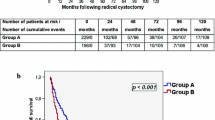Abstract
Introduction
Very few studies have been published on seminal vesicle invasion (SVI), and these have obtained conflicting results. The aim of the present investigation was to determine the most frequent of three possible routes of seminal vesicle invasion: (1) extraprostatic extension (EPE) into soft tissue adjacent to the seminal vesicle and then into the wall of the seminal vesicle, (2) invasion via the sheath of the ejaculatory duct, penetrating the muscular wall of the ejaculatory duct or extending up the ejaculatory duct into the seminal vesicle muscle wall, or (3) discontinuous metastases.
Materials and methods
The surgical specimens of 230 consecutive patients submitted to radical prostatectomy were histologically evaluated by complete embedding and whole-mount processing.
Results
Of the surgical specimens obtained from 230 patients, 28 (12.17%) showed the presence of either unilateral or bilateral SVI. The routes of SVI in these 28 specimens were: (1) only via the sheath of the ejaculatory duct (0/28; 0%); (2) discontinuous metastases (3/28; 11%), (3) both EPE and via the sheath of the ejaculatory duct (6/28; 21%), and (4) only EPE (19/28; 68%). One-half (14/28; 50%) of the 28 seminal vesicles involved had unilateral invasion and, in most of these cases (42.85%), EPE was unilateral and ipsilateral.
Conclusion
Our results suggest that the most important and most frequent route of SVI is extraprostatic extension of prostate carcinoma into the soft tissue adjacent to the ipsilateral seminal vesicle and then into the wall of the seminal vesicle.




Similar content being viewed by others
References
Villers AA, McNeal JE, Redwine EA et al (1990) Pathogenesis and biological significance of seminal vesicle invasion in prostatic adenocarcinoma. J Urol 143:1183–1187
Ohori M, Scardino PT, Lapin SL et al (1993) The mechanisms and prognostic significance of seminal vesicle involvement by prostate cancer. Am J Surg Pathol 17:1252–1261
Epstein JI, Partin AW, Potter SR et al (2000) Adenocarcinoma of the prostate invading the seminal vesicle: prognostic stratification based on pathologic parameters. Urology 56:283–288
Walsh PC (1986) Radical retropubic prostatectomy. In: Walsh PC, Gittes RF, Perlmutter AD, Stamey TA, (eds) Campbell’s urology, 5th edn, vol. 3. WB Saunders, Philadelphia, pp 2754–2775
Epstein JI, Carmichael M, Walsh PC (1993) Adenocarcinoma of the prostate invading the seminal vesicle: definition and relation of tumor volume, grade and margins of resection to prognosis. J Urol 149:1040–1045
Bostwick DG, Montironi R (1997) Evaluating radical prostatectomy specimens: therapeutic and prognostic importance. Virchows Arch 430:1–16
Gleason DF, Mellinger GT and the Veterans Administration Cooperative Urological Research Group (1974) Prediction of prognosis for prostatic adenocarcinoma by combined histological grading and clinical staging. J Urol 111:58–64
Gleason DF (1992) Histologic grading of prostate cancer: a perspective. Hum Pathol 23:273–279
Humphrey PA (2003) Prostate pathology. ASCP Press, Chicago, pp 301–303
Byar DP, Mostofi FK (1972) Carcinoma of the prostate: prognostic evaluation of certain pathologic features in 208 radical prostatectomies. Examined by the step-section technique. Cancer 30:5–13
Epstein JI, Walsh PC, Carmichael M et al (1994) Pathologic and clinical findings to predict tumor extent of nonpalpable (stage T1c) prostate cancer. JAMA 271:368–374
Epstein JI, Amin M, Boccon-Gibod L et al (2005) Prognostic factors and reporting of prostate carcinoma in radical prostatectomy and pelvic lymphadenectomy specimens. Scand J Urol Nephrol [Suppl] 216:34–63
Author information
Authors and Affiliations
Corresponding author
Rights and permissions
About this article
Cite this article
Billis, A., Teixeira, D.A., Stelini, R.F. et al. Seminal vesicle invasion in radical prostatectomies: Which is the most common route of invasion?. Int Urol Nephrol 39, 1097–1102 (2007). https://doi.org/10.1007/s11255-007-9189-7
Received:
Accepted:
Published:
Issue Date:
DOI: https://doi.org/10.1007/s11255-007-9189-7




